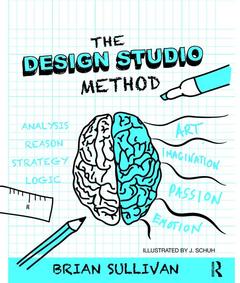The Design Studio Method Creative Problem Solving with UX Sketching

The struggle with balancing creative products that are innovative, technically feasible, and financially sound is one designers and web professionals go through every day. The Design Studio Method is a creative problem solving process that allows you to quickly generate ideas, evaluate them, and reach consensus, achieving that balancing act. Brian Sullivan?s The Design Studio Method gives answers that you have been looking for, showing you how to be innovative and efficient without sacrificing quality and collaboration. This book simplifies the complicated method, explaining each step, each participant?s involvement, and how to adapt the method to your needs.
The Design Studio Method provides step-by-step procedures to ensure your success. From illumination, to generation, to presentation, all the way to iteration, this book provides the road map you?ll need to start generating innovate products.
- Shows you how to involve all members of the creative process?from clients to directors?so that everyone participates, critiques, and innovates.
- Features real-world examples of Design Studio projects that highlight the successes of this method and ways to adapt it to your needs.
- Includes a website that showcases videos covering each step of the method and other procedures that crop up along the way.
Chapter 1: All about Design Studios
- What is a Design Studio?
- When Do You Do a Design Studio?
- A Word of Caution
- Other UX Sketching Methods
- Sketchboarding
- 6-UP
- RIPS
- Summary and Tips
Chapter 2: Generating and Evaluating Ideas
- Use Whole-Brain Thinking
- Generate Ideas with Left-Brain
- Evaluate Ideas with Right-Brain
- Four Rules for Generating Ideas
- Strive for Quantity
- Defer Judgment (Positive and Negative)
- Seek New Combinations
- Use Your Imagination
- Four Rules for Evaluating Ideas
- Use Positive Judgment First
- Consider Novelty
- Stay Focused
- Redirect, If Needed
- Summary
Chapter 3: Steps in a Design Studio
- Is a Design Studio Needed for Your Project?
- Choose Participants
- Assign Roles
- Facilitator
- Sketcher
- Scribe
- Determine What to Sketch
- Sketch Initial Concepts
- Evaluate Sketches
- Vote on Best Sketches
- Re-sketch or Mash-up
- Debrief Meeting
- Summary
Chapter 4: Making Sketches Presentable
- Draw One Concept Per Page
- Do Not Use a Computer
- Use Markers and Paper
- Do Not Color Your Sketches
- Do Not Provide Too Much Detail
- Use Annotations and Arrows
- Provide a Brief Description
- Summary and Tips
Chapter 5: Controlling the Conversation
- Using Edward DeBono’s Thinking Hats
- White Hat for Fact Finding
- Blue Hat for Organizing
- Green Hat for Generating Ideas
- Yellow Hat for Positive Evaluations
- Black Hat for Critical Inspections
- Red Hat for Voting
- Summary and Tips
Chapter 6: Storing Your Work
- Keeping a Digital Record
- Access for Others to Review (Confidential or Open)
- Sharing with the Rest of the Team
- Serves as Vision Board for Future Projects
- Summary and Tips
Chapter 7: Sharing Your Results
- Build a Wireframe after the Design Studio
- Sharing with the Other Sketchers
- To gain consensus
- To get alignment
- Sharing with the Project Team
- To show off your project vision
- To get alignment
- Sharing with Executives
- To get executive buy-in
- To obtain funding and resources
- Summary and Tips
Chapter 8: Working with Remote People
- Keeping a Digital Record
- Access for Others to Review (Confidential or Open)
- Sharing with the Rest of the Team
- Serves as Vision Board for Future Projects
- Summary and Tips
Chapter 9: Next Steps
- Immediate Things to Do
- Sharing Your Final Sketches
- Preparing Your Wireframes
- Testing Your Results
- Low-Fidelity Testing
- RITE Testing
- Prototype Testing
- Summary and Tips
Date de parution : 08-2017
19.1x23.5 cm
Date de parution : 08-2015
19.1x23.5 cm
Thèmes de The Design Studio Method :
Mots-clés :
Design Studio Method; Design Studio; world; Tip; usability; DA VINCI; day; Design Studio Participant; nal; WORLD USABILITY DAY; sketch; Nal Sketches; creative; Idea; problem; Design Studio Projects; solving; White Hat Thinking; participant; Heuristic Inspection; projects; Nal Round; Remote Participants; Design Studio Process; User Research; Usability Test Results; Yellow Hat Thinking; Math; Black Hat Thinking; Red Hat Thinking; High Fidelity Mockup; Light Bulb Manufacturer; High Level Design Concepts; Conduct Design Research; Conduct User Research
